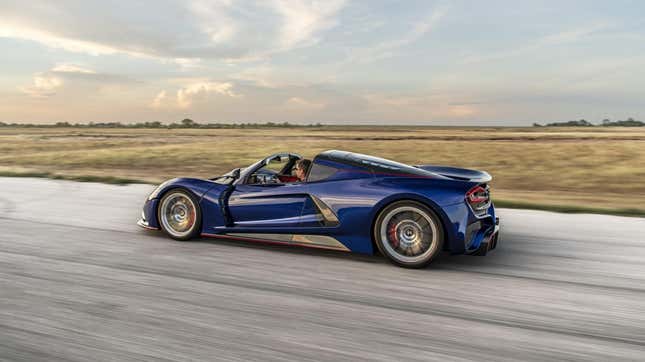Hennessey Venom F5 Shocks the World with 250 MPH Crash, Driver Miraculously Unscathed

 Hennessey Venom F5 Roadster driving on track">
Hennessey Venom F5 Roadster driving on track">They say fortune favors the bold, but on July 1, a bold Hennessey test driver needed more than just good fortune while testing the cutting-edge Venom F5 prototype. At a blistering 250 mph, the vehicle lost downforce and crashed at NASA's Kennedy Space Center in Florida. Miraculously, the driver emerged completely unscathed, a testament to the vehicle’s robust engineering and the quick response of emergency personnel.
The Incident
As per a statement by John Hennessey, the company's founder, the incident occurred during testing of a new aerodynamic setup for the 1,817-horsepower Venom F5. The team had not yet determined the cause of the downforce loss, but they are meticulously evaluating the aerodynamic data to uncover what led to this high-speed failure. John Hennessey acknowledged the relentless efforts of their engineering and technician teams, adding his gratitude towards the first responders and staff at the Kennedy Space Center.
“I am very grateful to our team of engineers and technicians who have designed and built an amazingly strong vehicle. We are also very thankful to the first responders and staff at KSC for their quick response to ensure everyone’s safety.”
Aerodynamic Experimentation
Hennessey reassured current Venom F5 owners that this particular mishap was limited to the prototype undergoing new aerodynamic experimentation. Regular Venom F5s, boasting a top speed claim of over 300 mph, should remain safe under typical extreme conditions. However, that astonishing top speed claim awaits validation in real-world runs.
The Venue
The Kennedy Space Center, with its expansive 2.81-mile-long runway and paved overruns, has become a favorite for manufacturers seeking a venue for top-speed runs. Notably, Bugatti hosted an event last May where Chiron owners experienced life at 250 mph at the same location. It’s an ideal spot for pushing the boundaries of automotive performance, but it also poses enormous risks.
The Aftermath and The Future
While Hennessey has refrained from releasing images or videos of the crash, the fact remains that walking away from a crash at such speed is almost miraculous. Despite the crash, Hennessey remains unbowed in its quest to produce some of the fastest cars on Earth, invoking the spirit of John F. Kennedy's famous words, “We don’t do these things because they are easy. We do them because they are hard.” It’s a powerful sentiment that drives Hennessey to continually push the envelope of what’s possible in automotive engineering.
This incident serves as a stark reminder of the inherent risks that come with breaking barriers in speed and performance. But it also underscores the incredible resilience and dedication of the Hennessey team in their unwavering pursuit of automotive excellence.